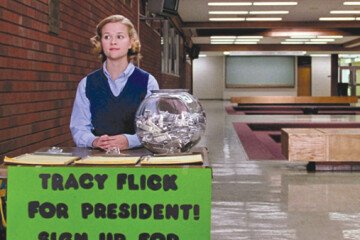Like a Stuffed Aardvark: The Psycho Sheep of Butte
This is the time of year when the nights start to arrive sooner and cooler. The landscape shifts from green and yellow to russet, golden, and crimson. It’s fall, those few brilliant weeks before powder fever turns southwest Montana into a winter amusement park. For many, the season of autumn arrives with cravings for braised meat, savory stew, and fireside whiskey. If you’re like me, though, that appetite is a constant and the change in season stirs a different want. I’m talking about scary movie time.
I would argue that this time of year encourages scary movie watching because the scary story genre was born from the campfire. As long as people have sat around a fire, the dark unknown sitting just beyond them and their desire to confront that fear has manifested into storytelling. Art history can chart horror through paintings, literature, theater, and film from as far back as the medieval until the contemporary. But I say it started at the fireside and it is enjoying a renaissance thru cinema, a medium that does suspense better than any other. (Don’t miss the chance to revel in classic horror movie bliss when Bozeman Film Society shows Nosferatu with live musical score by Next Door Prison Hotel at the Crawford Theater on October 29th).
I recently sat down with local filmmaker, Colin McWilliams, to talk about his first feature film, a horror/sci-fi B-movie, Psycho Sheep of Butte. The film is about a taxidermist (Erik Kreis) who is hounded by a debt collector (Robin Evans) and takes a bus from Butte to Bozeman to sell a stuffed aardvark to the Museum of the Rockies. Larry, the taxidermist, rises to challenge after challenge on his Homerian trek to Bozeman, the most insurmountable of them being a flock of aggressive, bloodthirsty sheep. Larry manages to survive their rampage by befriending a sheepherder (Jeffrey T. Spicer) who understands the sheep, and the entire world McWilliams constructs, better than anyone else. As the sheep invasion builds, the Montana militia gets involved and there may or may not be a raining eye spaceship involved in the climax. It’s definitely wacky but the script (written by McWilliams, Cyndi McWilliams, and Kreis) and the performances keep the film centered in campy shtick right where it belongs. The greatest achievement is that McWilliams knows exactly what kind of movie he’s making.
McWilliams says the film was shot and edited over the course of 7 years from 1998 thru 2005. He described their production model by saying, “We’d start with a pot of coffee early in the morning and then look over storyboards I’d made the night before and then get in the car and drive all over this great state and film what we could”. The film is shot in black and white with MiniDV tape on a Canon XL-1. McWilliams worked the sound and camera for the first half of production until he realized he couldn’t wear all the hats and his wife, Cyndi, took over shooting. It looks and sounds amateur at times. The camera and editing struggle when shooting in a car, a notoriously troublesome space to photograph (especially on a budget). But there are moments of total cinematic greatness.
When the sheriff is called to investigate the sheep’s strange behavior he climbs over a fence. The sheriff does not jump over gracefully or charge through it with blind machismo, he teeters on the wire. He struggles to keep his balance and moves slowly and carefully so as not to snag his pants or fall while straddling barbed wire. The scene is long. McWilliams shows the entire process and includes as many insert shots as he can. The duration, the camera work, and the performance come together to make an ordinary event deliciously suspenseful. McWilliams says that his goal with filmmaking is to show the “experience of what Montana is, where people are decent.” I think this scene does exactly that. The sheriff is not meant to be a hero nor a doofus. He’s just a guy doing his job. And then, of course, his neck is torn open by a psychotic herd of sheep. NBD.
The film premiered in Butte at the Venus Rising Espresso House in 2005 as part of a Winter Film Series. Tickets were $2. McWilliams described the festival interest in his film outside of Montana as “tepid”. So, he took on the distribution of the film himself and had DVDs made thru an Amazon-partner website called Create Space. The film is available to stream thru Amazon Instant Video. Which is how I watched it. But lucky for you – the film is now available to rent on DVD at Movie Lovers. I talked to McWilliams about the differences between watching the movie in a theater, renting a DVD in a store to watch at home, and then streaming the video thru a TV or computer. He said watching the film in a packed theater at the Butte premiere was like watching a totally different movie. We talked about the way digital film distribution could improve access to independent and low-budget films. But McWilliams also made comparisons between a video store and a book club, claiming that the ‘Netflix recommends’ algorithm will never compare to a knowledgeable video store clerk who develops a relationship with their customer. Regardless, film distribution and the way we consume media is rapidly changing. The Internet is wreaking havoc on an old system that we are loath to give up. McWilliams says we are always riding the curve with technology. By the time he finished shooting PSOB the Canon 5D was on the market and he felt out of the loop still using DV tapes.
When Larry the taxidermist first gets the call from Diane, the debt collector, he is “working” on the aardvark that will be his golden ticket out of debt. What it looks like on the screen is that Larry is wrapping duct tape around a wad of paper towel shaped like an aardvark. Having met McWilliams I feel comfortable assuming the set piece was chosen for comic effect. And if we’re not meant to laugh at the prop, the audience is certainly aloud to laugh at the assertion that Larry isn’t the world’s greatest taxidermist. But it doesn’t matter. Kreis sells the idea that this thing in his hand is worth $7,000. And that’s all we need to know.
This is such an important idea in cinema, the suspension of disbelief. No movie is as real as it feels. But the audience will believe what they see because they want to. There is a David Lynch YouTube clip where he bemoans the experience of watching a movie on an iPhone. And it made me think about talking to McWilliams about the different ways we can watch a film. David Lynch makes movies to be seen projected on a screen. Maybe McWilliams was ahead of his time, and unknowingly made a film to be seen streaming on the Internet. No matter where or how you watch it, get in touch with your primal campfire self, and watch a scary movie this Halloween season.



